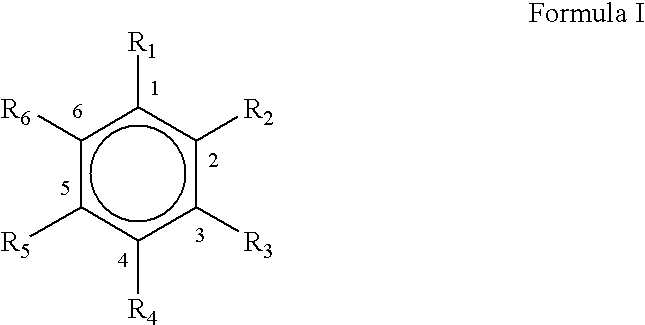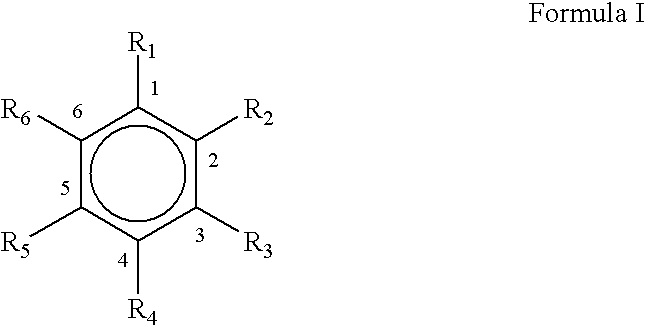Microwave assisted rapid and economical process for the preparation of substituted phenylaldehydes from trans and cis-phenylpropenes: a commercial utilisation of toxic cis-isomer
a technology of cis-phenylpropene and phenylaldehyde, which is applied in the preparation of carbonyl compounds, carbonyl compound preparations, oxidation, etc., can solve the problems of one or more process deficiencies, insufficient percentage of substituted phenylaldehydes in the plant kingdom, etc., and achieves low yield, high yield, and easy and safe
- Summary
- Abstract
- Description
- Claims
- Application Information
AI Technical Summary
Benefits of technology
Problems solved by technology
Method used
Image
Examples
example i
Reaction: ##STR1##
(a) Preparation of asaronaldehyde (2,4,5-trimethoxybenzaldehyde) from .beta.-asarone (by microwave irradiation method): A mixture of .beta.-asarone (3.1 g, 0.015 mmol), catalytic amount of OsO.sub.4 (0.04 to 0.002 g), NaIO.sub.4 (11.75 g, 0.055 mmol), benzyltriethyl ammonium chloride (catalytic amount) and THF-H.sub.2 O (8-10 mL, 4:1) were taken in a 100 ml Erlenmeyer flask fitted with a loose funnel at the top. The flask was shaken well and placed inside a microwave oven operating at medium power level and irradiated for 2-12 minutes in parts. After completion of the reaction (monitored by TLC), the contents of the flask were poured into chloroform and passed through a bed of Celite and further washed with chloroform. The filtrate and washings were combined and the chloroform layer were washed with sodium thiosulphate to destroy the excess periodate. The chloroform layers were then combined and washed with saturated sodium chloride (3.times.15 m), dried over anhyd...
example ii
Preparation of 3,4-dimethoxybenzaldehyde from methyl isoeugenol (by microwave method): The starting material methyl isoeugenol (3,4-dimethoxy phenylpropene) can be easily prepared by fast 0-methylation of cheaper and easily available isoeugenol (3-methoxy-4-hydroxy-phenylpropene) for which a mixture of isoeugenol (2.46 g, 0.015 mole), dry dimethyl sulphate (1.8 g, 0.14 mole), anhydrous potassium carbonate (6 g, 0.062 mole) and dry acetone (15-20 mL) was irradiated in a microwave oven for 8-10 minutes in parts. After completion of reaction (monitored by TLC) the contents of the flask were poured into ice water. The product was taken in ether (50-60 mL) and the ether layer was washed with dilute hydrochloric acid, saturated sodium bicarbonate and brine respectively and dried over anhydrous sodium sulphate and filtered. The solvent was removed under reduced pressure to afford a desired product methyl isoeugenol (2.32 g, 87% yield) which was used directly for next step.
A solution of OsO...
example iii
Preparation of 4-methoxybenzaldehyde from Anethole (by Microwave Method):
A solution of OsO.sub.4 (0.004-0.007 g), anethole (2.22 g, 0.015 mole), finely powdered NaIO.sub.4 (9.0 g, 0.044 mole) in THF-H.sub.2 O(20-25 mL) was irradiated in a microwave oven for 2-8 minutes in parts. The precipitated sodium iodate was filtered and the filtrate was washed with CH.sub.2 Cl.sub.2. The combined organic layers were washed with sodium thiosulphate, brine and dried over Na.sub.2 SO.sub.4. Evaporation of the solvent furnished a crude mixture, which was loaded on silica gel column, and the column was eluted with increasing amount of hexane / ethyl acetate (98:2 to 80:20). The fractions were monitored on TLC plate and the desired fractions were combined and solvent was removed under vacuum to afford 4-methoxybenzaldehyde in 71% yield as a sweet smell liquid; .sup.1 H NMR .delta. 9.95 (1H, s, CHO), 7.82 (1H, s, 6H), 7.79 (1H, s, 2H), 6.99 (1H, s, 5H), 6.96 (1H, s, 5H), 3.84 (3H, s, 4-OCH.sub.3). The ...
PUM
| Property | Measurement | Unit |
|---|---|---|
| microwave radiation frequency | aaaaa | aaaaa |
| radiation frequency | aaaaa | aaaaa |
| temperature | aaaaa | aaaaa |
Abstract
Description
Claims
Application Information
 Login to View More
Login to View More - R&D
- Intellectual Property
- Life Sciences
- Materials
- Tech Scout
- Unparalleled Data Quality
- Higher Quality Content
- 60% Fewer Hallucinations
Browse by: Latest US Patents, China's latest patents, Technical Efficacy Thesaurus, Application Domain, Technology Topic, Popular Technical Reports.
© 2025 PatSnap. All rights reserved.Legal|Privacy policy|Modern Slavery Act Transparency Statement|Sitemap|About US| Contact US: help@patsnap.com



